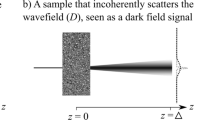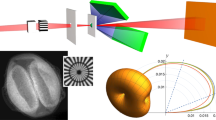Abstract
Imaging with visible light today uses numerous contrast mechanisms, including bright- and dark-field contrast, phase-contrast schemes and confocal and fluorescence-based methods1. X-ray imaging, on the other hand, has only recently seen the development of an analogous variety of contrast modalities. Although X-ray phase-contrast imaging could successfully be implemented at a relatively early stage with several techniques2,3,4,5,6,7,8,9,10,11, dark-field imaging, or more generally scattering-based imaging, with hard X-rays and good signal-to-noise ratio, in practice still remains a challenging task even at highly brilliant synchrotron sources12,13,14,15,16,17,18. In this letter, we report a new approach on the basis of a grating interferometer that can efficiently yield dark-field scatter images of high quality, even with conventional X-ray tube sources. Because the image contrast is formed through the mechanism of small-angle scattering, it provides complementary and otherwise inaccessible structural information about the specimen at the micrometre and submicrometre length scale. Our approach is fully compatible with conventional transmission radiography and a recently developed hard-X-ray phase-contrast imaging scheme11. Applications to X-ray medical imaging, industrial non-destructive testing and security screening are discussed.
This is a preview of subscription content, access via your institution
Access options
Subscribe to this journal
Receive 12 print issues and online access
$259.00 per year
only $21.58 per issue
Buy this article
- Purchase on Springer Link
- Instant access to full article PDF
Prices may be subject to local taxes which are calculated during checkout



Similar content being viewed by others
References
Murphy, D. B. Fundamentals of Light Microscopy and Electronic Imaging (Wiley, New York, 2001).
Bonse, U. & Hart, M. An X-ray interferometer with long separated interfering beam paths. Appl. Phys. Lett. 6, 155–156 (1965).
Davis, T. J., Gao, D., Gureyev, T. E., Stevenson, A. W. & Wilkins, A. W. Phase-contrast imaging of weakly absorbing materials using hard X-rays. Nature 373, 595–598 (1995).
Ingal, V. N. & Beliaevskaya, E. A. X-ray plane-wave topography observation of the phase contrast from non-crystalline objects. J. Phys. D 28, 2314–2317 (1995).
Chapman, D. et al. Diffraction enhanced x-ray imaging. Phys. Med. Biol. 42, 2015–2025 (1997).
Snigirev, A., Snigireva, I., Kohn, V., Kuznetsov, S. & Schelokov, I. On the possibilities of X-ray phase contrast microimaging by coherent high-energy synchrotron radiation. Rev. Sci. Instrum. 66, 5486–5492 (1995).
Wilkins, S. W., Gureyev, T. E., Gao, D., Pogany, A. & Stevenson, A. W. Phase-contrast imaging using polychromatic hard X-rays. Nature 384, 335–337 (1996).
Momose, A. Recent advances in X-ray phase imaging. Japan J. Appl. Phys. 44, 6355–6267 (2005).
Momose, A., Yashiro, W., Takeda, Y., Suzuki, Y. & Hattori, T. Phase tomography by X-ray Talbot interferometry for biological imaging. Japan J. Appl. Phys. 45, 5254–5262 (2006).
Weitkamp, T. et al. Quantitative X-ray phase imaging with a grating interferometer. Opt. Express 13, 6296–6304 (2005).
Pfeiffer, F., Weitkamp, T., Bunk, O. & David, C. Phase retrieval and differential phase-contrast imaging with low-brilliance X-ray sources. Nature Phys. 2, 258–261 (2006).
Morrison, G. R. & Browne, M. T. Dark-field imaging with the scanning-transmission X-ray microscope. Rev. Sci. Instrum. 63, 611–614 (1992).
Chapman, H. N., Jacobsen, C. & Williams, S. A characterisation of dark-field imaging of colloidal gold labels in a scanning transmission X-ray microscope. Ultramicroscopy 62, 191–213 (1996).
Suzuki, Y. & Uchida, F. Dark-field imaging in hard X-ray scanning microscopy. Rev. Sci. Instrum. 66, 1468–1470 (1995).
Pagot, E. et al. A method to extract quantitative information in analyzer-based X-ray phase contrast imaging. Appl. Phys. Lett. 82, 3421–3423 (2003).
Levine, L. E. & Long, G. G. X-ray imaging with ultra-small-angle X-ray scattering as a contrast mechanism. J. Appl. Cryst. 37, 757–765 (2004).
Ando, M. et al. Clinical step onward with X-ray dark-field imaging and perspective view of medical applications of synchrotron radiation in Japan. Nucl. Instrum. Methods A 548, 1–16 (2005).
Shimao, D., Sugiyama, H., Kunisada, T. & Ando, M. Articular cartilage depicted at optimized angular position of Laue angular analyzer by X-ray dark-field imaging. Appl. Radiat. Isot. 64, 868–874 (2006).
von Ardenne, M. Das Elektronen-Rastermikroskop. Z. Tech. Phys. 19, 407–416; Z. Phys. 109, 553–572 (1938).
Ramberg, E. G. Phase contrast in electron microscope images. J. Appl. Phys. 20, 441–444 (1949).
Lohmann, A. W. & Silva, D. E. An interferometer based on the Talbot effect. Opt. Commun. 2, 413–415 (1971).
Yokozeki, S. & Suzuki, T. Shearing interferometer using grating as beam splitter. Appl. Opt. 10, 1575–1579 (1971).
Pfeiffer, F. et al. Shearing interferometer for quantifying the coherence of hard X-ray beams. Phys. Rev. Lett. 94, 164801 (2005).
Weitkamp, T., David, C., Kottler, C., Bunk, O. & Pfeiffer, F. Tomography with grating interferometers at low-brilliance sources. SPIE Int. Soc. Opt. Eng. 6318, 28–32 (2006).
Harding, G. X-ray scatter tomography for explosives detection. Radiat. Phys. Chem. 71, 869–881 (2004).
Harding, G. & Schreiber, B Coherent X-ray scatter imaging and its applications in biomedical science and industry. Radiat. Phys. Chem. 56, 229–245 (1999).
Fernandez, M. et al. Small-angle X-ray scattering studies of human breast tissue samples. Phys. Med. Biol. 47, 577–592 (2002).
Fernandez, M. et al. Human breast cancer in vitro: Matching histo-pathology with small-angle X-ray scattering and diffraction enhanced X-ray imaging. Phys. Med. Biol. 50, 2991–3006 (2005).
David, C. et al. Fabrication of diffraction gratings for hard X-ray phase contrast imaging. Microelectron. Eng. 84, 1172–1177 (2007).
Bech, M. et al. X-Ray imaging with the PILATUS 100K detector. Appl. Radiat. Isot. (2007, in the press) (doi:10.1016/j.apradiso.2007.10.003).
Acknowledgements
We gratefully acknowledge C. Kottler for help with the experiments and T. Weitkamp and S. Wilkins for discussions.
Author information
Authors and Affiliations
Contributions
F.P., M.B. and C.D. conceived the experimental set up. C.D. and C.G. designed and fabricated the gratings. O.B. interfaced the experimental hardware and data acquisition system. F.P. wrote the data analysis software. C.B., E.F.E. and P.K. were responsible for the detector hardware, software and calibration. F.P. and M.B. analysed and interpreted the data.
Corresponding author
Supplementary information
Supplementary Information
Supplementary figures S1 and S2 (PDF 395 kb)
Rights and permissions
About this article
Cite this article
Pfeiffer, F., Bech, M., Bunk, O. et al. Hard-X-ray dark-field imaging using a grating interferometer. Nature Mater 7, 134–137 (2008). https://doi.org/10.1038/nmat2096
Received:
Accepted:
Published:
Issue Date:
DOI: https://doi.org/10.1038/nmat2096
This article is cited by
-
Grating-based x-ray dark-field CT for lung cancer diagnosis in mice
European Radiology Experimental (2024)
-
Implementation of a dual-phase grating interferometer for multi-scale characterization of building materials by tunable dark-field imaging
Scientific Reports (2024)
-
X-ray dark-field computed tomography for monitoring of tissue freezing
Scientific Reports (2024)
-
On the quantification of sample microstructure using single-exposure x-ray dark-field imaging via a single-grid setup
Scientific Reports (2023)
-
Spectral X-ray dark-field signal characterization from dual-energy projection phase-stepping data with a Talbot-Lau interferometer
Scientific Reports (2023)



